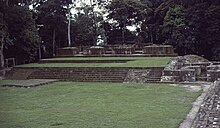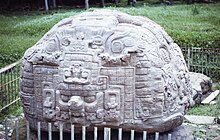Quiriguá
| Quirigua Archaeological Park and Ruins | |
|---|---|
|
UNESCO world heritage |
|

|
|
| Detail of Zoomorph B (780) |
|
| National territory: |
|
| Type: | Culture |
| Criteria : | (i) (ii) (iv) |
| Reference No .: | 149 |
| UNESCO region : | Latin America and the Caribbean |
| History of enrollment | |
| Enrollment: | 1981 ( session 5 ) |
Coordinates: 15 ° 16 ′ 0 ″ N , 89 ° 4 ′ 0 ″ W.
Quiriguá is a pre-Columbian Maya city in what is now the Department of Izabal in Guatemala ; since 1981 it is one of the UNESCO - World Heritage Site .
history
Quiriguá is a medium-sized site on the lower reaches of the Río Motagua . The ceremonial center is about 1 km from the left bank of the river. What is unusual about Quiriguá is the fact that almost all of the sculptures are in excellent condition and have been dated with inscriptions. The period of habitation falls into the Classical Period of Mayan Culture. Settlement began around 200, the construction of the Acropolis around 550, the heyday with the magnificent buildings began from 700 and around 850 all construction work came to an end. The rise of the city is based on the victory of the King of Quiriguá K'ak 'Tiliw Chan Yopaat over Copán in 738. Quiriguá was previously probably a vassal state of Copán and became independent afterwards.
Ruin site
architecture
The proportion of large ceremonial buildings is - compared to the total area and the importance of Quiriguá - quite small. At the southern end of the Plaza Grande rises the so-called Acropolis, the ceremonial and palace city of Quiriguá. It was built from around 550 to around 810; even an older ball playground was built over. You can still see the wide stairs that lead to the newer ball playground and the foundation walls of a palace building with 3 entrances.
sculpture
More important than the architecture are the many sculptures Quiriguá, which are among the most impressive of ancient Mesoamerica . These include unusually high steles (see, for example, the picture above), which were elaborately cut from monolithic stone blocks. The largest is more than 10 meters high and weighs about 60 tons. In addition to the tall vertical steles, there are a number of boulders that have been elaborately shaped into the shape of mythological animals. These sculptures are known as zoomorphs ; in their size they are almost unique. Various altars and sculptures can also be found in the decorations on the building facades.
However, some of the monuments in Quiriguá show exceptional craftsmanship. Probably the best example is stele D (766) with extraordinary full-body anthropomorphic versions of the Mayan hieroglyphs on one side; the other surfaces of the stele are also processed. The Zoomorph B (780) still shows traces of red color; the Zoomorph P (795) was the discoverer Maudslay as The Great Turtle ( Large turtle called). Both monuments represent masterpieces of Mesoamerican sculpture.
Overall, the artistic quality of the sculptures does not come close to that of Palenque or Copán. Most of the monuments are monumentally formal and appear austere compared to the natural grace of the art of these other locations.
Modern history of Quiriguá
Quiriguá was rediscovered in modern times by Frederick Catherwood in 1840. Due to adverse circumstances, he was only able to stay at the ruins for a short time. However, he made drawings of two steles which, along with a brief travel description, were published in John Lloyd Stephen's book Incidents of Travel in Central America, Chiapas, and Yucatan . A lengthy investigation of the ruins was carried out in 1854 by Karl Scherzer. From 1881 to 1883, Alfred Maudslay set up a camp near the ruins and carried out a very careful investigation during which he photographed all the visible monuments, carried out some minor excavations and made paper and plaster casts of all hieroglyphic inscriptions and the most important sculptures. These prints were then shipped to England; today they are in the British Museum . Maudslay visited Quiriguá again in 1894.
In 1910, the United Fruit Company bought Quiriguá and all of the land in the wider area for banana planting. An area of 120,000 m² has been designated as an archaeological zone. This includes the ruins and their immediate surroundings. Further archaeological work was carried out in 1910–1914 by Edgar Lee Hewitt for the School of American Research at Santa Fe . Copies of the stelae, based on his plaster casts, were exhibited at the Panama-California Exposition in San Diego in 1915 . The Carnegie Mellon University led 1915-1934 sporadically by some projects.
An extensive archaeological project funded by the University of Pennsylvania , the National Geographic Society and the Government of Guatemala was undertaken in Quiriguá from 1975 to 1980. The steles were covered by palm roofs for protection - especially from the chemical pesticides sprayed from airplanes.
See also
literature
- Nikolai Grube (Ed.): Maya. God kings in the rainforest. Könemann, Cologne 2000, ISBN 3-8290-1564-X .
- Matthew G. Looper: New Perspectives on the Late Classic Political History of Quirigua, Guatemala. In: Ancient Mesoamerica 10/2, 1999
- Simon Martin / Nikolai Grube: Chronicle of the Maya Kings and Queens. Deciphering the Dynasties of the Ancient Maya. Thames & Hudson, 2nd ed., London 2008, ISBN 978-0-500-28726-2 , pp. 214-225.
- Linda Schele , David Freidel : The unknown world of the Maya. The secret of their culture deciphered. Weltbild Verlag, Augsburg 1995, ISBN 3-89350-737-X .
- Walter RT Witschey: Encyclopedia of the Ancient Maya , 2015, pp. 285–287
Web links
- Entry on the UNESCO World Heritage Center website ( English and French ).
- Quiriguá: A Mayan Legacy in Stone Essay with many pictures
- Enigmatic Quiriguá
- Photos of Quiriguá Stela (French)
- Story with photos (English)






